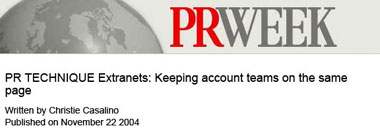PR TECHNIQUE Extranets: Keeping account teams on the same page

An extranet can be a vital conduit of communication between an agency's account team and its client contacts. Christie Casalino looks at best practices.
A breakdown in communication is a severe blight on any relationship, and those between employees are no exception. So it's no mystery why so many PR firms use intranets to help communications flow seamlessly.
"A key component of intranets is about engaging employees," says Warren Engal, a senior consultant at Porter Novelli.
"To do that, it's most important to be completely transparent in terms of the internal information you share."
Much of this information is proprietary to the organization. But in order for account teams to be able to function at the highest possible level, many need a real-time communications platform with their counterparts on the client side. "That's why we work very closely with our clients to develop extranets, because clearly there is an important role for collaboration to play in the client-agency relationship," Engal adds.
For a firm, an extranet can pick up where an intranet leaves off. In addition to boosting communication between staffers, clients are no longer left in the dark about an account's progress.
But with all the tech advances, questions on many topics will arise, such as what facts determine the need for an extranet, will the service be cost-efficient, who should have access to the information, and what should be included.
Andy Getsey, cofounder of Atomic Public Relations, says there was no questioning the creation of an extranet when he started the firm five years ago.
"We designed this right from the start, before even taking on a single employer or client," says Getsey of Atomic's extranet structure. "All of our clients want to work this way; it's partially why they choose us."
Based on information shared by the company's intranet, its extranet hosts such tools as real-time news tracking, awards and editorial calendars, workgroup calendars, and remote presentation software.
Getsey adds that the shared information removes barriers usually set by time constraints. "If a client has a question on Sunday [about] whether we reached a journalist on a Friday, they can answer those questions on their own easily."
But Getsey advises researching your clients' needs before creating the extranet. If they're interested in a collaborative effort, posting drafts might be acceptable, while others might wish to only use it for disseminating information - in which case everything posted must be proofed, with read-only status.
Matthew Wahn, a senior account supervisor with Hill & Knowlton, suggests making sure that an extranet will be fully utilized by promoting its features to the client.
"It's cost-effective when people use it. If you invest in a system and you're not getting day-to-day involvement, like any technology investment, you haven't spent your money wisely."
Explore these sites
- Best Non Gamstop Casinos Uk
- Casino Non AAMS
- Gambling Sites Not On Gamstop
- Non Gamstop Casinos
- Online Casino ελλαδα
- Slots Not On Gamstop
- Casino Not On Gamstop
- Casino En Ligne Fiable
- Best Non Gamstop Casinos
- Casinos Not On Gamstop
- UK Casinos Not On Gamstop
- Slots Not On Gamstop
- Non Gamstop Casinos UK
- Non Gamstop Casinos UK
- Non Gamstop Casino Sites UK
- Non Gamstop Casino
- Meilleur Casino En Ligne Retrait Immédiat
- Casino Not On Gamstop
- Online Casinos
- Non Gamstop Casino Sites UK
- New Non Gamstop Casinos

